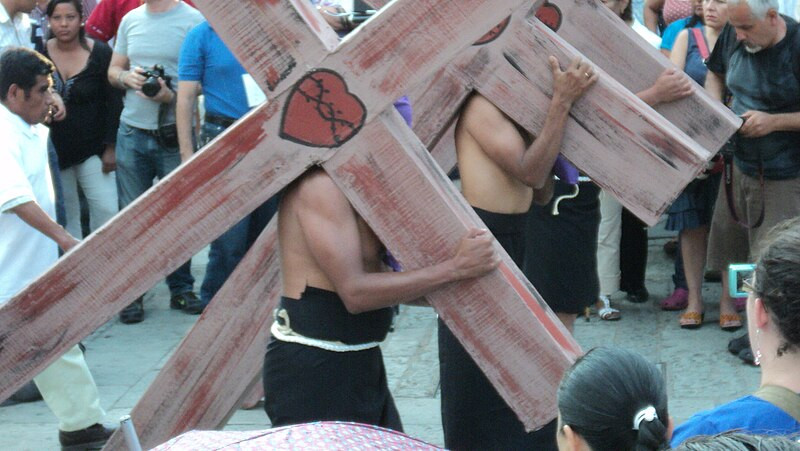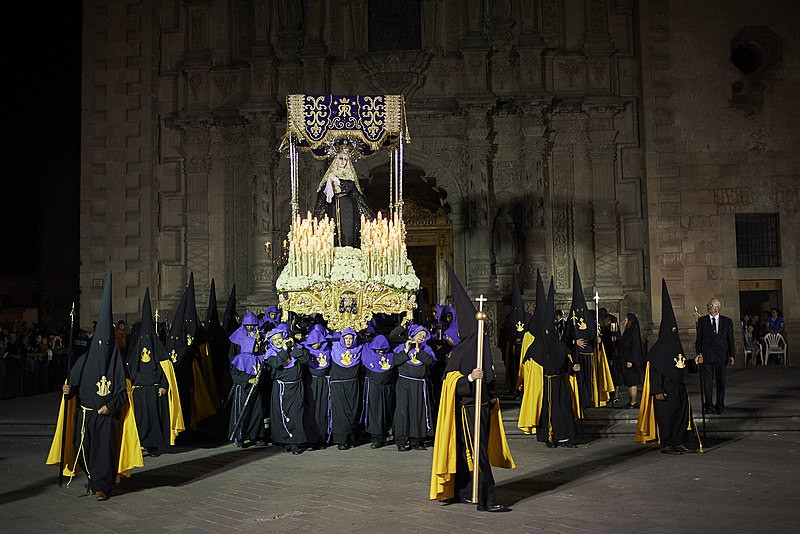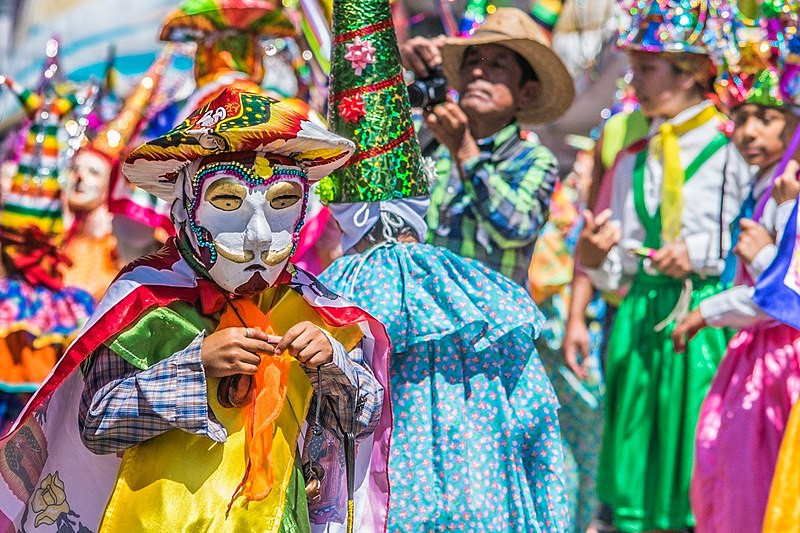How Is Holy Week Celebrated In Mexico? Gaymexico.net is your ultimate guide to understanding this vibrant and culturally rich celebration, especially for the LGBTQ+ community seeking inclusive and welcoming experiences in Mexico. Discover the traditions, destinations, and spiritual significance of Semana Santa, ensuring a memorable and respectful journey with insider tips and resources tailored for the LGBTQ+ traveler.
1. What Is Holy Week and Why Is It Important in Mexico?
Holy Week, or Semana Santa in Spanish, is a week-long religious observance in Mexico commemorating the final week of Jesus Christ’s life, including his crucifixion and resurrection. It’s a deeply significant period, blending profound religious devotion with vibrant cultural traditions that showcase Mexico’s rich heritage and strong Catholic influence.
Holy Week in Mexico is more than just a religious event; it’s a cultural phenomenon that brings communities together. According to research from the UCLA Williams Institute, cultural celebrations play a vital role in fostering a sense of belonging and identity, particularly for LGBTQ+ individuals. Semana Santa offers an opportunity to witness elaborate processions, reenactments of biblical events, and heartfelt prayers, all while experiencing the warmth and hospitality of Mexican culture.
2. What Are Some Unique Holy Week Traditions and Customs in Mexico?
Mexico’s Holy Week traditions are rich and diverse, reflecting a blend of indigenous customs and Catholic practices. Some of the unique customs include:
- Alfombras (Sawdust Carpets): Intricately designed carpets made of colorful sawdust, flowers, and other materials adorn the streets, creating vibrant pathways for processions.
- Passion Plays (Reenactments): Communities stage dramatic reenactments of the Passion of Christ, depicting key events from the Last Supper to the crucifixion.
- Processions: Elaborate processions wind through the streets, featuring religious statues, music, and participants dressed in traditional attire.
- Traditional Foods: Special dishes are prepared and shared, such as capirotada (a bread pudding symbolizing the crucifixion) and tortitas de camarón (shrimp patties).
These traditions aren’t just performances; they are expressions of faith and cultural identity. Research from the Pew Research Center indicates that religious traditions significantly impact cultural identity, particularly among Mexicans. Experiencing these customs firsthand offers a deeper understanding of Mexican culture and its spiritual roots.
 Elaborate sawdust carpets known as alfombras adorn the streets during Holy Week processions in Mexico, showcasing vibrant cultural and religious traditions with intricate designs and colorful patterns.
Elaborate sawdust carpets known as alfombras adorn the streets during Holy Week processions in Mexico, showcasing vibrant cultural and religious traditions with intricate designs and colorful patterns.
3. How Does Holy Week Differ Between Mexico and Spain?
While both Mexico and Spain celebrate Holy Week, there are notable differences in their customs and traditions:
| Feature | Mexico | Spain |
|---|---|---|
| Orientation | More community-oriented, with lively street processions and colorful displays. | Often features solemn processions with elaborate floats depicting scenes from the Passion of Christ, accompanied by somber music and incense. |
| Atmosphere | Celebratory and vibrant, with a strong emphasis on community participation. | More subdued and reflective, with a focus on religious piety and penitence. |
| Indigenous Influence | Often incorporates indigenous traditions and beliefs, resulting in a unique blend of cultural and religious practices. | Primarily rooted in Catholic traditions, with less influence from indigenous cultures. |
| Visuals | Colorful alfombras, decorated streets, and lively reenactments. | Elaborate floats, hooded penitents (nazarenos), and solemn religious imagery. |
Understanding these differences can enrich your experience of Holy Week, allowing you to appreciate the unique cultural expressions in each country. As noted by the Spanish Tourist Office, experiencing Semana Santa in Spain offers a glimpse into the country’s deep religious heritage, while Mexico provides a vibrant fusion of indigenous and Catholic traditions.
4. What Are the Key Dates of Holy Week and When Does It Typically Occur?
Holy Week typically falls in late March or early April, following the Christian calendar. The key dates include:
- Palm Sunday: Commemorates Jesus’ triumphant entry into Jerusalem.
- Holy Monday to Holy Wednesday: Days of reflection and preparation for the events of the Passion.
- Holy Thursday: Celebrates the Last Supper and the institution of the Eucharist.
- Good Friday: Observes the crucifixion and death of Jesus.
- Holy Saturday: A day of mourning and anticipation.
- Easter Sunday: Celebrates the resurrection of Jesus Christ.
These dates are pivotal in the Christian faith, representing the culmination of Lent and the triumph of life over death. Being aware of these dates will help you plan your trip and participate in the most meaningful events. According to the Catholic News Agency, attending services on these days offers a profound spiritual experience.
5. What Destinations in Mexico Are Known for Their Holy Week Celebrations?
Several destinations in Mexico are renowned for their unique and elaborate Holy Week celebrations:
| Destination | Highlights |
|---|---|
| Taxco, Guerrero | Elaborate processions, intricate alfombras, and a strong sense of religious devotion. Be aware some processions are silent and show blood. |
| Iztapalapa, Mexico City | Grand reenactment of the Passion of Christ, attracting locals and visitors alike. |
| San Luis Potosi | Solemn processions and a blend of faith and natural beauty. |
| Dolores Hidalgo, Guanajuato | Lively parades, colorful floats, and a strong sense of community. |
| Patzcuaro, Michoacan | Blend of indigenous customs and Catholic traditions, with reenactments of the Last Supper and vibrant processions. |
| Oaxaca | Colorful alfombras, traditional foods, and performances of pastorelas (biblical plays). |
Each destination offers a unique cultural experience, allowing you to witness the diversity of Mexican traditions. Websites like GayMexico.net provide detailed guides to these destinations, offering LGBTQ+-friendly recommendations for accommodations, activities, and cultural experiences.
 The Procession of Silence in San Luis Potosi during Holy Week in Mexico, a solemn tradition that commemorates the passion and death of Christ with hooded figures and a somber atmosphere.
The Procession of Silence in San Luis Potosi during Holy Week in Mexico, a solemn tradition that commemorates the passion and death of Christ with hooded figures and a somber atmosphere.
6. What Are Some Traditional Foods Associated with Holy Week in Mexico?
Food plays a central role in Holy Week celebrations, with specific dishes carrying religious and cultural significance:
- Capirotada: A bread pudding made with bread, cheese, cinnamon, and dried fruits, symbolizing the crucifixion of Jesus.
- Tortitas de Camarón: Shrimp patties, often eaten on Good Friday as a meatless option.
- Romeritos: A stew made with a green herb called “romero,” potatoes, dried shrimp, and mole sauce, representing the crown of thorns.
- Bacalao: Salted codfish prepared in various ways.
- Empanadas de Vigilia: Meatless turnovers filled with cheese, potatoes, or seafood.
These dishes are not just meals; they are symbols of faith and remembrance. According to culinary historians, traditional foods like capirotada have been passed down through generations, preserving cultural heritage and spiritual beliefs.
7. How Can LGBTQ+ Travelers Experience Holy Week in Mexico Safely and Respectfully?
For LGBTQ+ travelers, experiencing Holy Week in Mexico requires sensitivity and awareness of local customs:
- Research LGBTQ+-friendly destinations: Some cities and regions are more welcoming to LGBTQ+ individuals. Puerto Vallarta, Mexico City, and Cancun are known for their LGBTQ+ scenes.
- Respect local traditions: Be mindful of religious customs and dress modestly when attending religious events.
- Seek out inclusive accommodations: Look for hotels and guesthouses that cater to LGBTQ+ travelers.
- Connect with local LGBTQ+ communities: Engage with local LGBTQ+ organizations for insider tips and support.
- Stay informed: Stay updated on local laws and customs regarding LGBTQ+ rights and safety.
Websites like GayMexico.net provide resources and information to help LGBTQ+ travelers navigate Mexico safely and respectfully. According to Human Rights Watch, while Mexico has made strides in LGBTQ+ rights, attitudes can vary by region, making it essential to be informed and prepared.
8. What Is the Significance of “Alfombras” During Holy Week?
Alfombras, or sawdust carpets, are a significant part of Holy Week celebrations in Mexico. These intricate creations are made from colorful sawdust, flowers, and other natural materials. They are often used to decorate the streets through which religious processions pass.
The significance of alfombras includes:
- Religious Expression: They serve as a form of prayer and devotion, with designs often depicting religious symbols and biblical scenes.
- Artistic Skill: Creating alfombras requires considerable skill and artistry, showcasing the community’s creative talents.
- Community Collaboration: Families and communities work together to create these carpets, fostering a sense of unity and shared purpose.
- Temporary Beauty: The ephemeral nature of alfombras symbolizes the fleeting nature of earthly life and the importance of spiritual values.
These carpets are more than just decorations; they are expressions of faith and community spirit. Art historians note that the tradition of creating alfombras dates back centuries, evolving from indigenous practices to become an integral part of Holy Week celebrations.
 Intricately designed sawdust carpets known as alfombras in Mexico during Holy Week, showcasing religious symbolism and the artistic talent of local communities with their colorful patterns.
Intricately designed sawdust carpets known as alfombras in Mexico during Holy Week, showcasing religious symbolism and the artistic talent of local communities with their colorful patterns.
9. How Do Passion Plays Reflect the Story of Jesus’s Last Days in Mexico?
Passion plays, or reenactments of the Passion of Christ, are a central part of Holy Week celebrations in Mexico. These plays depict the key events of Jesus’s last days, from the Last Supper to his crucifixion and resurrection.
The significance of Passion plays includes:
- Religious Education: They serve as a visual and emotional way to convey the story of Jesus’s sacrifice and resurrection.
- Community Engagement: Local actors and community members participate in the plays, fostering a sense of shared identity and purpose.
- Cultural Preservation: The plays preserve cultural traditions and religious beliefs, passing them down through generations.
- Spiritual Reflection: They encourage viewers to reflect on the meaning of Jesus’s sacrifice and its relevance to their own lives.
These plays are powerful reminders of the central themes of Christianity and their cultural impact on Mexican society. Religious scholars emphasize that Passion plays are a form of religious expression that has deep roots in Christian history.
10. What Safety and Respect Tips Should LGBTQ+ Travelers Keep in Mind During Holy Week in Mexico?
To ensure a safe and respectful experience during Holy Week in Mexico, LGBTQ+ travelers should keep the following tips in mind:
| Tip | Description |
|---|---|
| Research Destinations | Choose LGBTQ+-friendly destinations known for their welcoming attitudes and inclusive environments. |
| Respect Local Customs | Be mindful of religious customs and traditions, especially when attending religious events. Dress modestly and avoid public displays of affection in more conservative areas. |
| Stay Informed | Stay updated on local laws and customs regarding LGBTQ+ rights and safety. Be aware of any potential risks or challenges and take necessary precautions. |
| Connect with Locals | Engage with local LGBTQ+ organizations and communities for insider tips and support. They can provide valuable insights and guidance for navigating the local culture. |
| Plan Accommodations | Book accommodations at LGBTQ+-friendly hotels or guesthouses that prioritize inclusivity and safety. |
| Be Mindful of Public Displays of Affection | While some areas may be more accepting, it’s generally advisable to avoid overt displays of affection in public, especially in more conservative regions. |
By following these tips, LGBTQ+ travelers can enjoy a safe, respectful, and enriching experience during Holy Week in Mexico. Gaymexico.net provides additional resources and information to help you plan your trip and connect with the LGBTQ+ community in Mexico.
Holy Week in Mexico is a time of profound religious devotion and vibrant cultural expression. For LGBTQ+ travelers, experiencing this celebration can be both enriching and meaningful, provided you approach it with respect and awareness. By researching LGBTQ+-friendly destinations, respecting local customs, and connecting with local communities, you can ensure a safe and memorable journey.
FAQ: Your Questions About Holy Week in Mexico Answered
1. Is Holy Week a good time to visit Mexico?
Yes, Holy Week can be a great time to visit Mexico, offering a unique opportunity to witness cultural and religious traditions. However, be prepared for larger crowds and higher prices.
2. Are all regions in Mexico equally welcoming to LGBTQ+ travelers during Holy Week?
No, some regions are more welcoming than others. Cities like Puerto Vallarta and Mexico City are known for their LGBTQ+ friendliness.
3. What should LGBTQ+ travelers wear during Holy Week processions?
Dress modestly and respectfully, avoiding overly revealing clothing.
4. Are there specific LGBTQ+ events during Holy Week in Mexico?
While Holy Week is primarily a religious observance, some LGBTQ+ venues may host special events. Check local listings for details.
5. How can I find LGBTQ+-friendly accommodations in Mexico?
Websites like Gaymexico.net and Airbnb offer listings of LGBTQ+-friendly hotels and guesthouses.
6. Is it safe for LGBTQ+ couples to show affection in public during Holy Week?
It’s best to avoid overt displays of affection in public, especially in more conservative areas.
7. What resources are available for LGBTQ+ travelers in Mexico?
Gaymexico.net provides a wealth of information and resources for LGBTQ+ travelers, including guides, tips, and community connections.
8. How can I participate in Holy Week celebrations respectfully?
Attend religious services, observe local customs, and show respect for the cultural traditions.
9. What is the best way to learn about the history and significance of Holy Week in Mexico?
Visit local museums, attend cultural events, and engage with local communities to learn about the history and significance of Holy Week.
10. Where can I find the latest information on LGBTQ+ rights and safety in Mexico?
Human Rights Watch and local LGBTQ+ organizations provide up-to-date information on LGBTQ+ rights and safety in Mexico.
Discover the heart of Mexico during Holy Week with gaymexico.net. Explore our guides to LGBTQ+-friendly destinations, connect with local communities, and experience the vibrant culture safely and respectfully. Your adventure awaits – start planning today. Visit gaymexico.net for more information.
Address: 3255 Wilshire Blvd, Los Angeles, CA 90010, United States.
Phone: +1 (213) 380-2177.